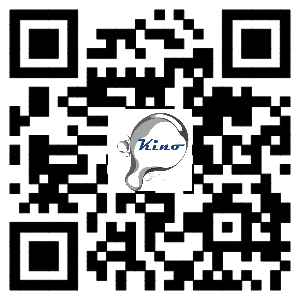From the perspective of contact angle measurement to see the mask processing requirements and how to reuse the mask?
Face mask is a protective and effective way
to protect human against COVID-19. Therefore, in 2020, masks have become a new
strategic material and one of the necessities of people's life. With China's
COVID-19 relief, the mask needs have eased, and the supply and demand of masks
have been initially resolved. During the period of severe epidemic, the supply
of mask was seriously insufficient, which led to the rapid expansion of
production capacity, although the vast majority of manufacturers were able to guarantee
the quality. However, in terms of protection, the process quality requirements
of masks, how to improve the protective performance of masks, how to improve
the efficiency of masks during the epidemic, and how to solve the problem of
repeated use of masks are still not fundamentally solved.
According to the classification of masks,
they are mainly divided into KN95 and similar level masks (including electric
masks), medical disposable masks, PM2.5 anti-haze masks, warm masks, disposable
ordinary masks, filter elements, etc. Among COVID-19, disposable medical masks
and KN95 level masks are currently recognized as effective for effective
prevention of new crown pneumonia.
From the perspective of the production
process of the mask, the medical mask is divided into three layers, the middle
of which is a filter layer with polypropylene melt —blown nonwoven, which can
filter bacteria or viruses, and prevent pathogenic microorganisms from invading
the human body and causing respiratory diseases. Medical masks are divided into
two types: medical surgical masks and medical N95 masks. Medical surgical masks
can filter about 30% of bacteria or viruses in the air to prevent them from
invading the human body. Medical surgical masks are suitable for the general
public. For people working in hospitals and epidemic prevention departments, it
is recommended to wear medical N95 masks, which can filter more than 95% of the
air Bacteria or viruses can avoid invading the respiratory system of human
body, while ordinary masks, anti-haze masks and warm masks have no filtering
function, only play a role of prevention and warmth preservation.
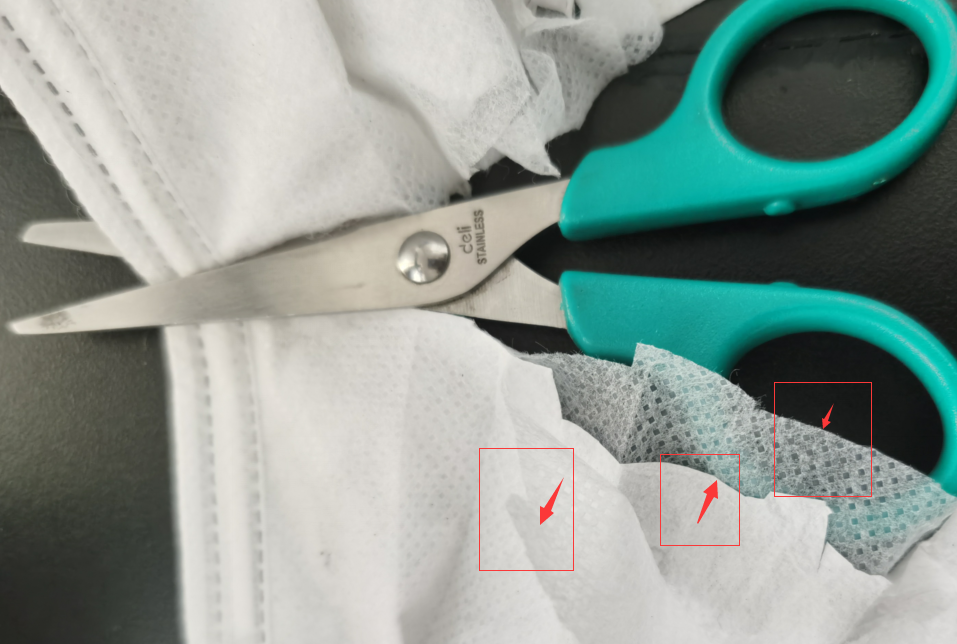
In Europe and 3M, KN masks are usually
provided with 5 layers, including the outer non-woven fabric layer, two layers
of melt blown fabric layer (ultra-fine polypropylene fiber melt blown material
layer), active carbon layer and inner layer of skin friendly material (ordinary
sanitary gauze or non-woven fabric).
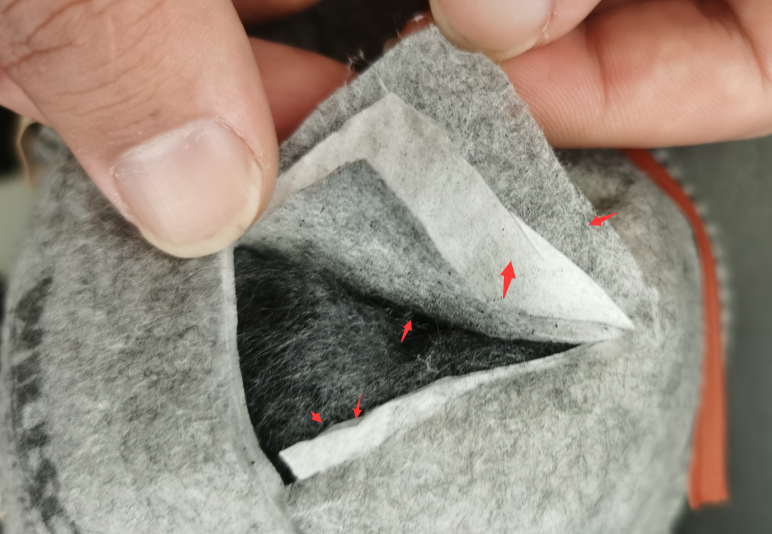
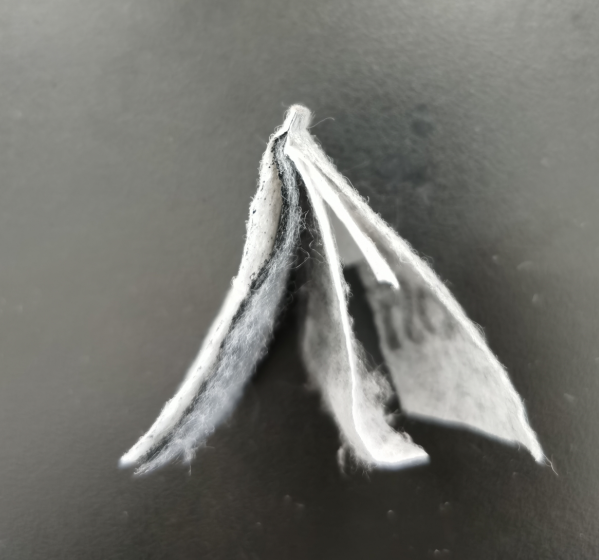
The ordinary KN95 mask usually has only
four layers, including the inner and outer non-woven fabric layers and the
middle two layers of melt blown fabric layers.
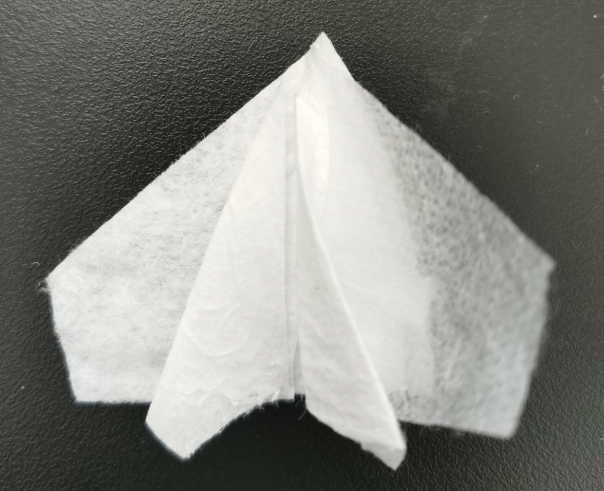
Xiaomi's Zhimi mask is provided with 5
layers, as shown in the figure below: the outer layer is made of polyurethane
sponge, the middle two layers of melt blown fabric layers and one layer of
primary effect filter on both sides
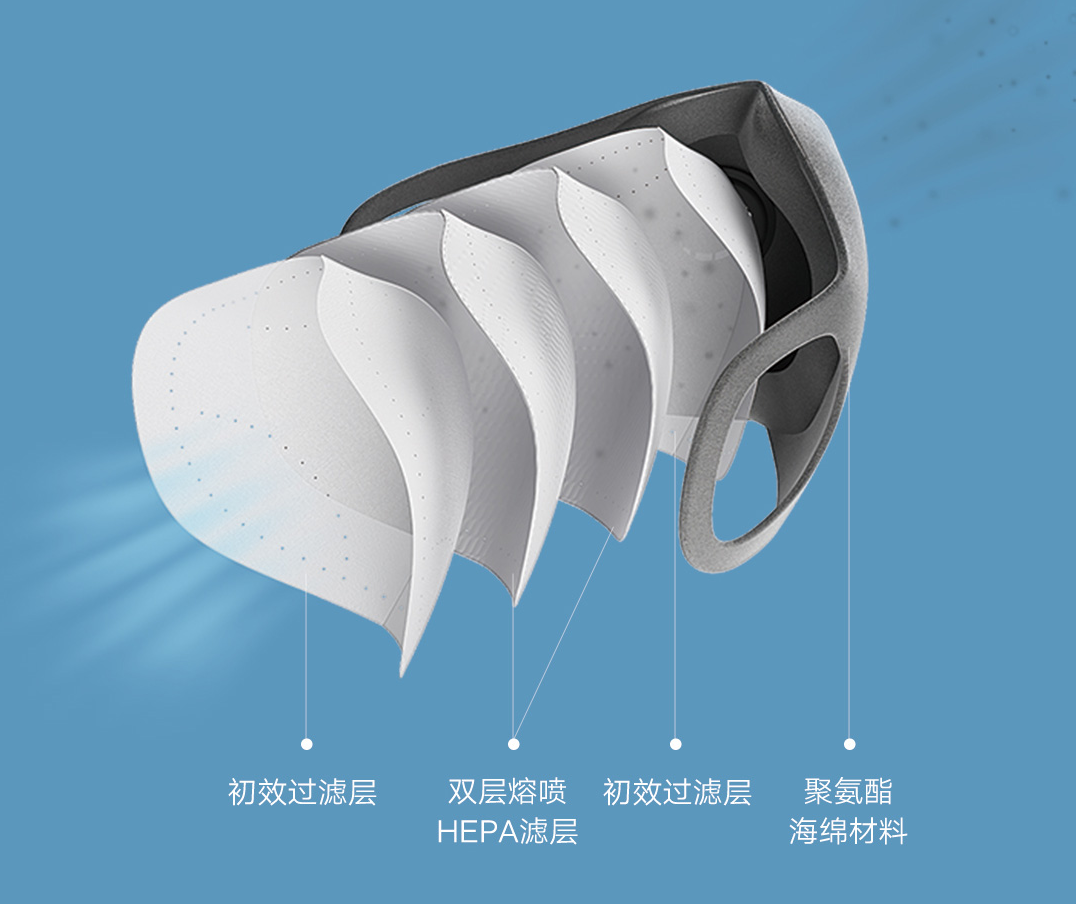
Medical mask and KN95 mask are effective in
protecting against COVID-19. The key is the layer of melt blown fiber layer
(ultra-fine polypropylene fiber melt blown material layer) in them. On February
6, the "can disposable masks be reused after sterilization" was
released by the Feiner electron microscope? ——The experimental results of
scanning electron microscopy
(https://mp.weixin.qq.com/s/alx9kvr818bvxj7nwu3ocg) are published. The conclusion
is: "even for the fiber as thin as 0.5 μ m (150 times thinner than the
hair), it is not as fragile as imagined. Compared with the control group, the
original microstructure of the fiber remained intact after immersion in 75%
alcohol, steaming and boiling in water, the diameter distribution and swelling
property of the fiber did not change, and no fiber fracture or corrosion was
found. " At the same time, they found that "after three times 75%
alcohol spray disinfection, the melt blown filber layer still has electrostatic
adsorption capacity."
In order to further reveal the production
process requirements, material performance requirements, and how to improve the
protective performance and service life of masks, especially the anti-virus
respirators, this paper will further demonstrate the interface chemistry and
contact angle analysis and measurement technology.
1 Material preparation:
1.1 Mask preparation:
We have prepared one electric mask
(YuanShengTai company), 3M warm mask, XiaoMi Zhimi mask, 3M R95 mask, European
Wilson FFP1, KN95 mask( Shanghai Gangkai purification products Co., Ltd.),
disposable medical mask, etc.
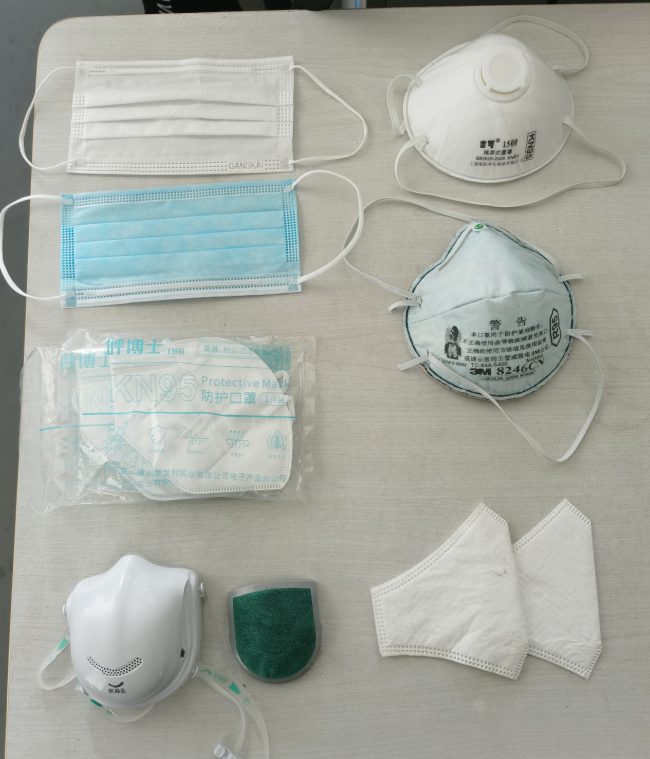
1.2 Distilled water, 75% medical alcohol
and alcohol cotton with 75% alcohol, 84 disinfectant water and 1:10 ratio were
used to prepare disinfectant.
1.3 Test equipment:
Contact angle meter (KINO, sl200ks), microwave oven (Haier), millet UV
disinfection machine (XiaoMi).
2 Test method:
2.1 The value contact angle of outer layer,
including cotton cloth (warm mask), non-woven cloth (medical mask and KN95
mask), polyurethane sponge material of XiaoMi mask, was measured by contact
angle meter.
2.2 Cut off the KN95 mask and disposable
medical mask with scissors, and take out the middle part of melt blown fabric
layer. The melt blown fabric layer was divided into 7 groups for comparative
test, including ① as the control group without any treatment, ② 75% alcohol immersing for 1 hour, ③ alcohol cotton scrubbing, ④ boiling in water for 10 minutes, ⑤ steaming in water for 7 minutes, ⑥ microwave with small fire for 2 minutes, ⑦ 84 disinfection
treatment. After alcohol immersing, alcohol scrubbing, water boiling, steam
steaming and 84 disinfection treatment, the blower is used to blow for 10
minutes and dry them in the air.
2.3 test method of Contact Angle:
2.3.1 The surface tension of distilled
water was measured by ADSA-RealDrop. If the surface tension value does not
conform to the literature value (20 ℃ 72.75mn/m, error ± 0.5mn / M), clean the needle and liquid syringe until the measured
value conforms to the literature value. Through this test process, ensure the
repeatability and comparability of the test results. The surface tension of the
test results is 18 ℃, 73.1mN/m)
2.3.2 After the test materials are clamped
with clamps to ensure the levelness, the laser level and the multi-tilted
sample stage using micrometer is used to adjust the levelness of the upper
surface of the sample, and then the contact angle is measured.
2.3.3 The test method of contact angle
measurement is ADSA-RealDrop, which can automatically correct the influence of
gravity and take the surface tension value into calculating of the contact
angle. ADSA algorithm can effectively avoid the influence of human error and
gravity. Other algorithms, such as Ellipse fitting, TrueDrop fitting and Circle
fitting, are not accurate and scientific because they are based on the
principle of protractor in 1980-90's when ADSA is not proposed.
2.3.4 Measure the contact angle of at least
3 positions of different outer layer materials, and take the average value.
2.3.5 The contact angles of 7 groups of
melt blown fabric layers were measured at least 3 positions respectively, and
the average value was taken.
3 Result and discussion:
3.1 The comparison results of contact angle
values of different materials on the outer layer of masks are as follows:
|
NO.
|
Type
|
Average value of CA (°)
|
|
1
|
Cloth layer of 3M Warm mask
|
138.09
|
|
2
|
Non-woven layer (hydrophobic treated) of Disposable
medical mask
|
137.12
|
|
3
|
Non-woven layer of Wilson's mask (FFP1)
|
123.94
|
|
4
|
Outer layer of original filter element
(YuanShengHuo’s electric mask, KN95)
|
120.35
|
|
5
|
Disposable mask filter element
|
118.63
|
|
6
|
Xiaomi’s polyurethane sponge
|
88.28
|
As
can be seen from the above data:
(1) The cotton layer of 3M warm mask and
other special treated cotton layers are usually treated with hydrophobic agent,
so the value of contact angle is usually large. In general, the contact angle
value can easily reach about 140 degrees. After super hydrophobic treatment,
the contact angle value can reach more than 150 degrees. It has excellent
hydrophobic and oil repellent performance, and can play a good waterproof,
oil-proof and dust-proof effect.
(2) The non-woven surface treatment of
disposable medical mask also has certain hydrophobic effect after hydrophobic
treated. However, this hydrophobic effect is actually due to its low surface
free energy and the fluffy structure of the non-woven fabric itself, which
holds up a small volume of test distilled water drop, and air cannot enter into
the pores between the fibers thus forming a pseudo hydrophobic contact angle
value. This contact angle value cannot withstand fatigue test or be used for
many times for a long time. After long-term use, it is easy to reduce the
contact angle.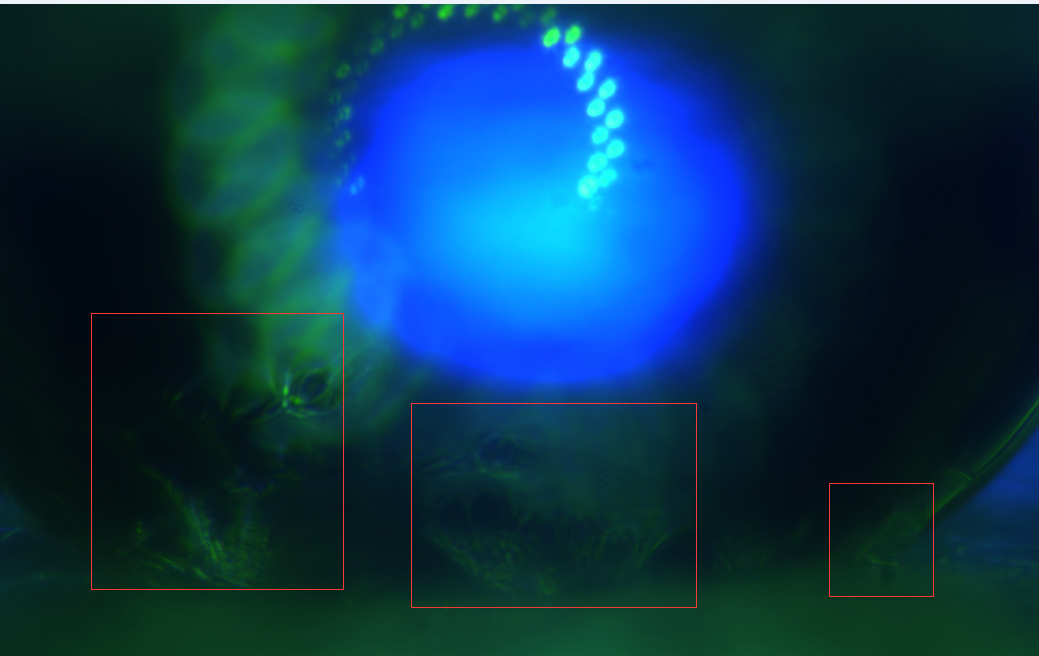
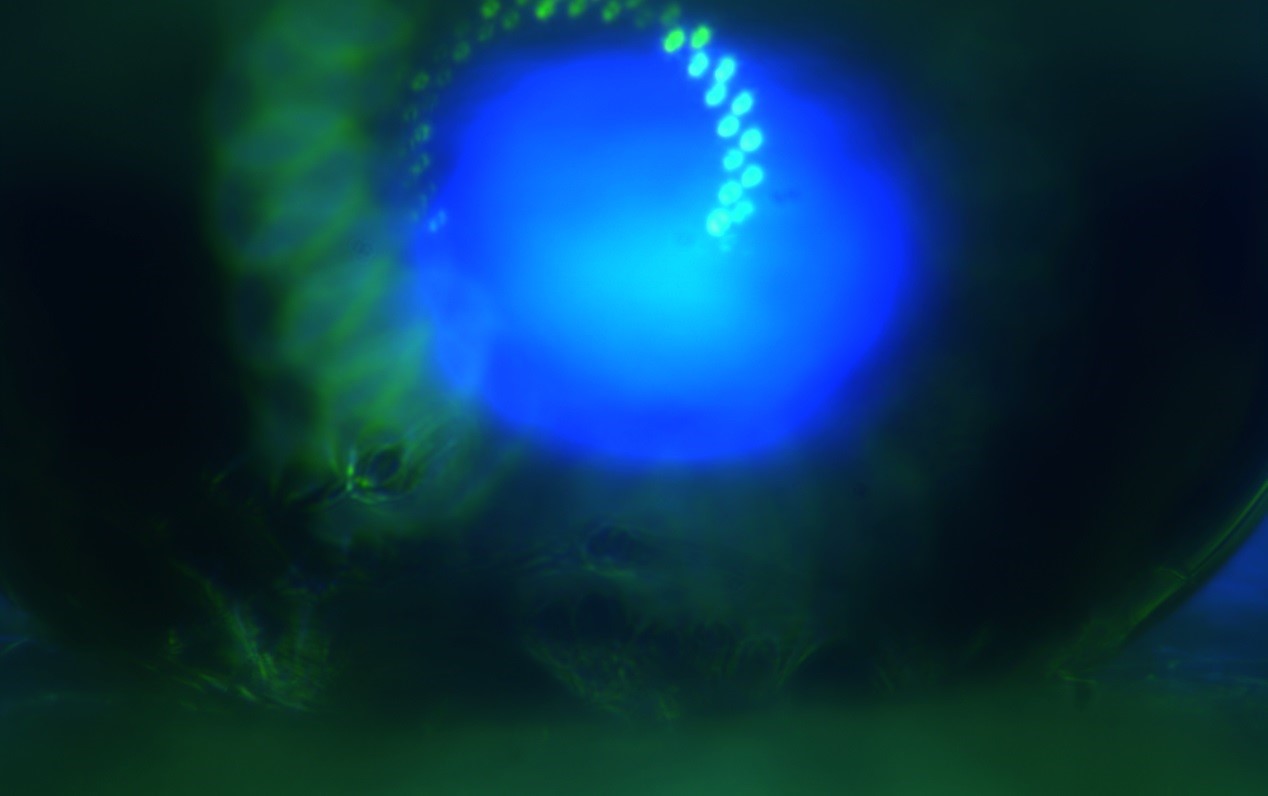
(3) Generally, the contact angle of
non-woven fabric and filter element material is about 120-130 degrees. This is
the actual contact angle value of the non-woven fabric without special
treatment, and this contact angle value is also the pseudo weak hydrophobic
angle characteristic of the non-woven fabric caused by the fluff structure
supporting the water drop.
(4) Polyurethane or untreated cotton cloth,
due to its weak hydrophilicity, has poor effect in practical application. So,
they are not recommended to use.
To sum up, as the outer material, our
proposal is that the hydrophobic treated cotton products or fiber products are
more suitable. While the inner layer is close to the skin layer of people, it
is recommended to use non-woven fabric layer to protect the skin and make
people feel more comfortable at the same time.
3.2 Typical pictures of Contact angle of
outer layer of masks.
(1) Cloth layer of 3M Warm mask
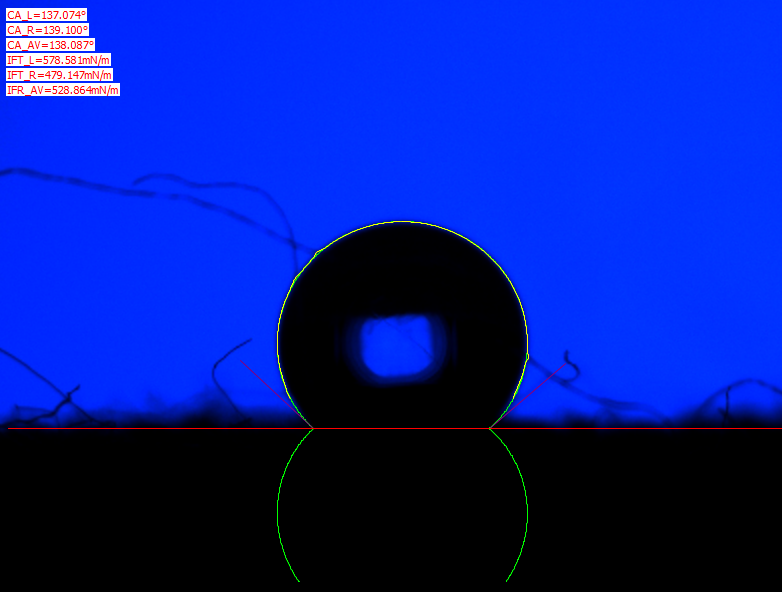
(2) Non-woven layer (hydrophobic treated)
of Disposable medical mask and KN95 mask
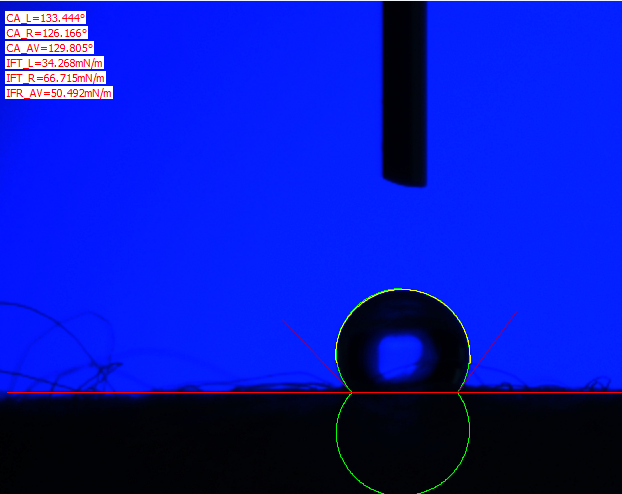
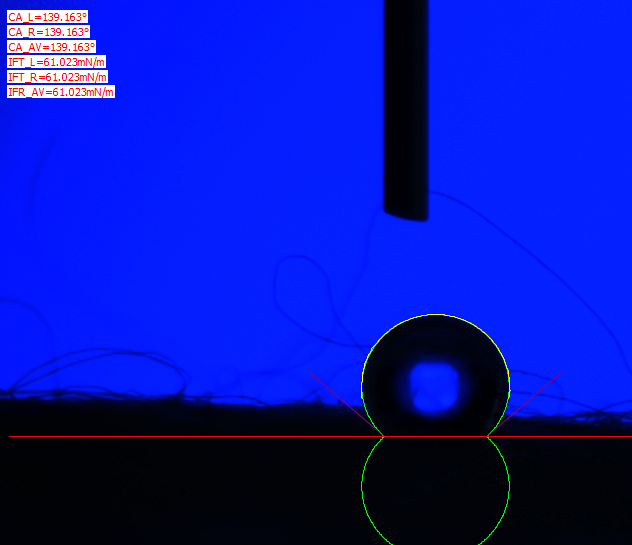
(3) Non-woven layer of Wilson's mask (FFP1)
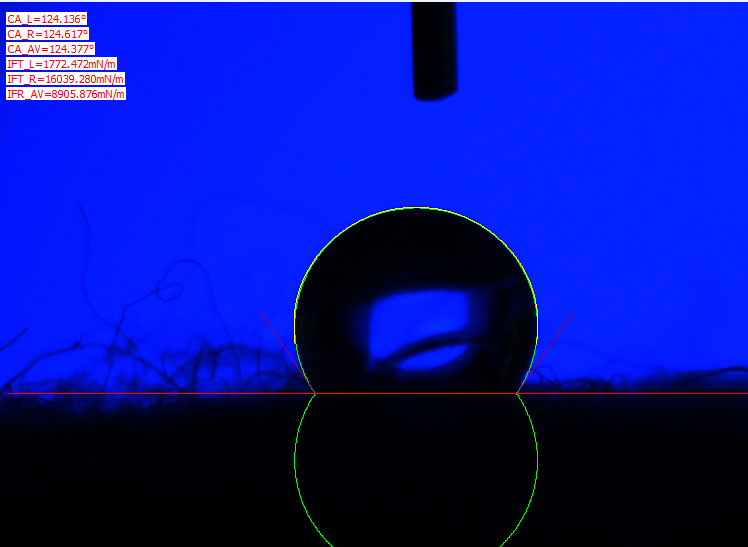
(4) Outer layer of original filter element
(YuanShengHuo’s electric mask, KN95)
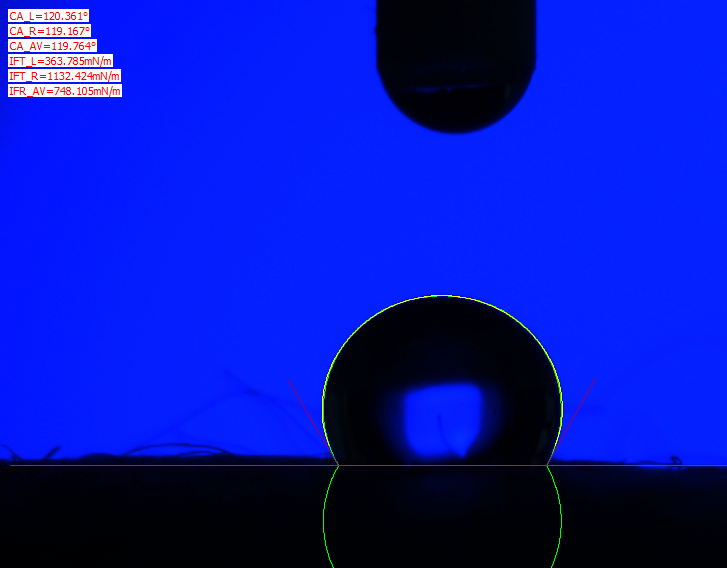
(5) Disposable mask filter element
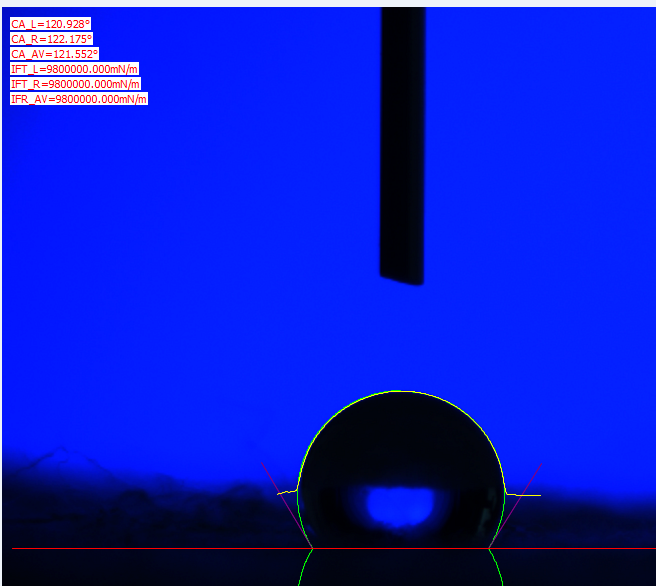
(6) Xiaomi’s polyurethane sponge
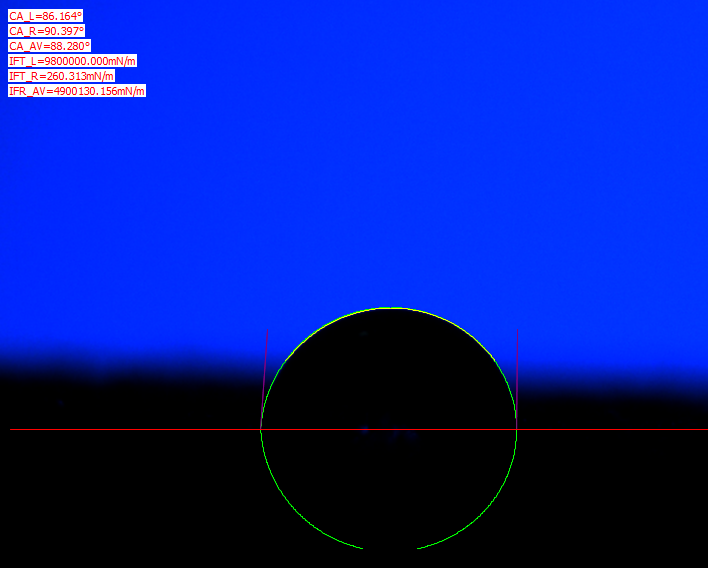
3.3 Contact angle measurement results of blown
melt fiber layer (ultra-fine polypropylene fiber melt blown material layer)
The results of contact angle measurement of
7 control groups are as follows:
|
No.
|
Type
|
Average value of CA (°)
|
|
1
|
control group without any treatment
|
138.59
|
|
2
|
75% alcohol immersing for 1 hour
|
139.29
|
|
3.1
|
alcohol cotton scrubbing 1 time
|
138.42
|
|
3.2
|
alcohol cotton scrubbing 2 times
|
136.41
|
|
3.3
|
alcohol cotton scrubbing 3 times
|
135.40
|
|
4
|
boiling in water for 10 minutes
|
136.38
|
|
5
|
steaming in water for 7 minutes
|
138.03
|
|
6
|
microwave with small fire for 2 minutes
|
141.13
|
|
7
|
84 disinfection treatment
|
0
|
As
can be seen from the above data:
(1) Alcohol immersion and alcohol cotton
scrubbing will not have a significant impact on the melt blown cloth. The
average contact angle value without treatment is 138.59 degrees, while the
contact angle value after alcohol immersion is 139.29 degrees, and the contact
angle value at the first time of alcohol cotton scrubbing is 138. This is the same
as "can disposable masks be reused after sterilization?"? ——The
results of SEM are consistent.
(2) Repeated scrubbing of alcohol cotton
will reduce the contact angle of the melt blown cloth, so repeated use of
alcohol cotton will probably shorten the service life of the melt blown cloth
and reduce the protection efficiency.
(3) Boiling water boiling and steam
steaming did not significantly change the contact angle, which was still
greater than 136 degrees. But the effect is worse than that of alcohol and
microwave treatment.
(4) The contact angle value of the melt
blown cloth can be increased obviously by heating in small fire in microwave
oven, so the protection efficiency can be improved obviously.
(5) The contact angle of 84 disinfectant
solution is obviously smaller after treatment, and the water drop is very easy
to penetrate into the melt blown lining. Therefore, 84 disinfectant cannot be
used for disinfection.
So, the conclusion can be drawn from the
above:
(1) Alcohol disinfection and water steaming
or boiling do not affect the contact angle value of the melt spray cloth, and
do not affect the protective effect of the mask. And the Alcohol is preferred.
(2) The minimum critical value of contact
angle for effective protection of melt blown cloth is recommended to be 135-136
degrees. The melt blown cloth with the contact angle lower than 135 degrees
shall be regarded as the unqualified product.
(3) 84 disinfectant cannot be used for
disinfection.
(4) Microwave heating and UV disinfection
is the best way to disinfect, it is recommended to use.
3.43.2 Typical pictures of Contact angle of
melt blown cloth
(1) control group without any treatment
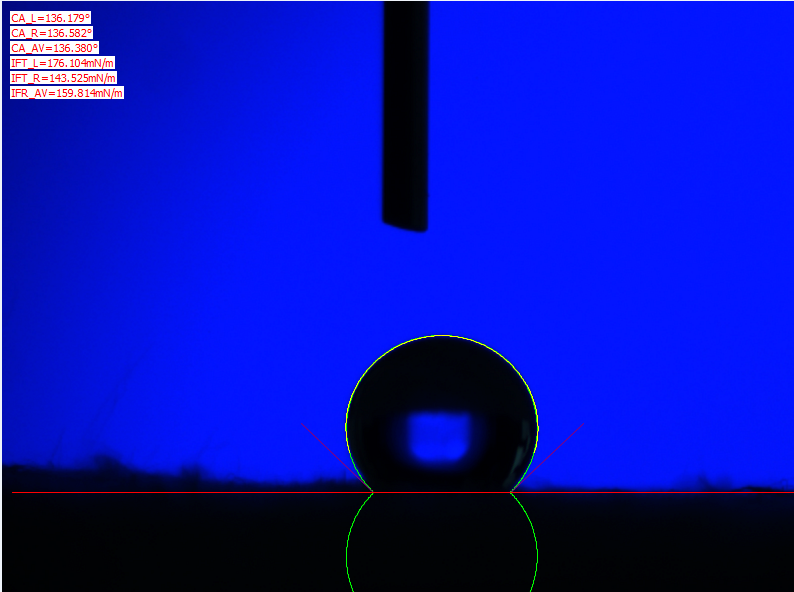
(2) 75% alcohol immersing for 1 hour
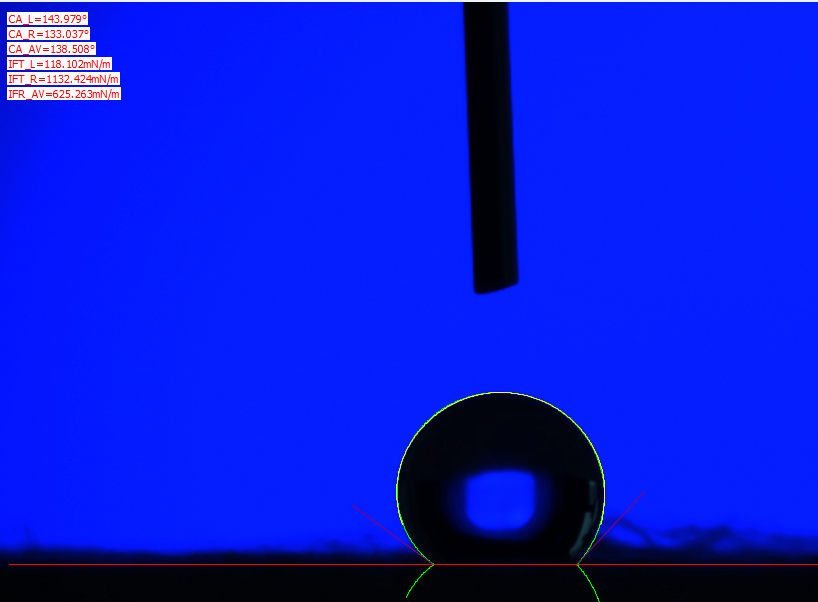
(3) alcohol cotton scrubbing 1 time
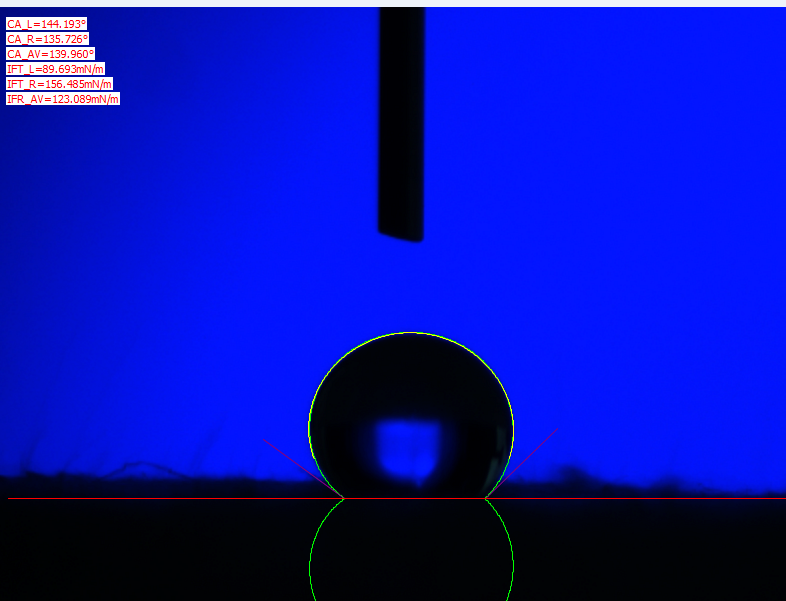
(4) boiling in water for 10 minutes
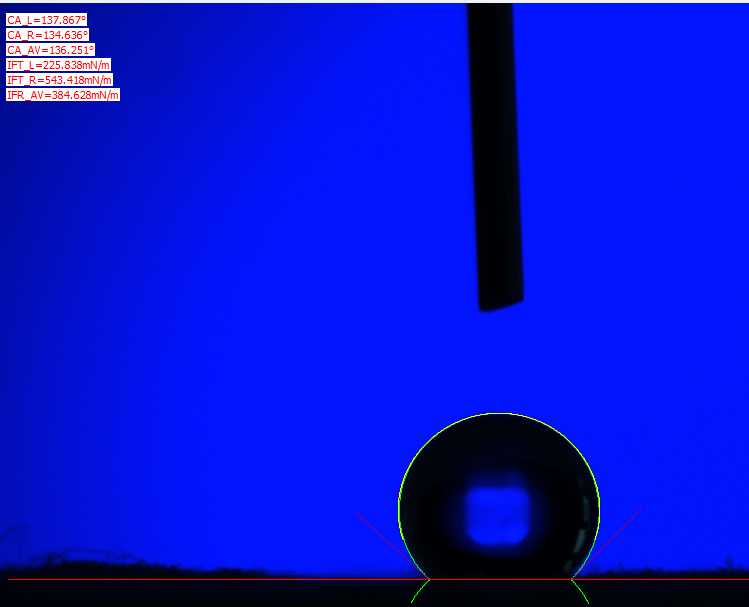
(5) steaming in water for 7 minutes
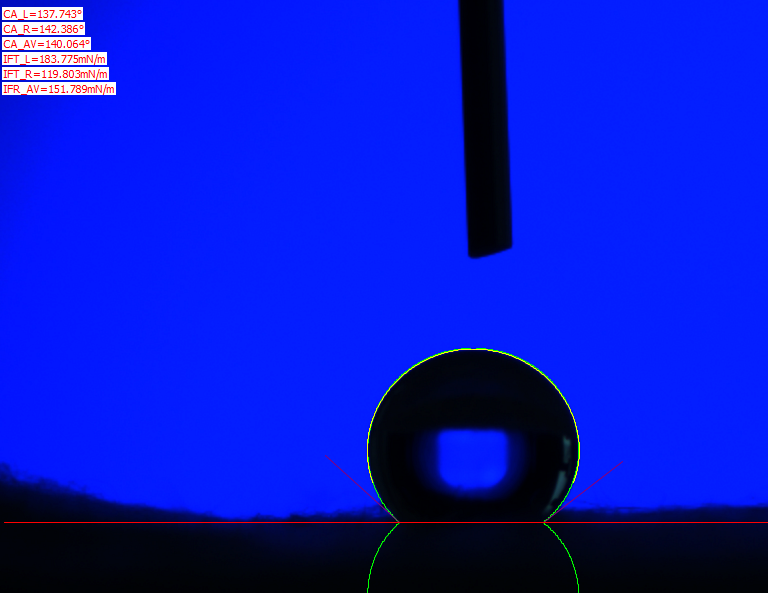
(6) microwave with small fire for 2 minutes
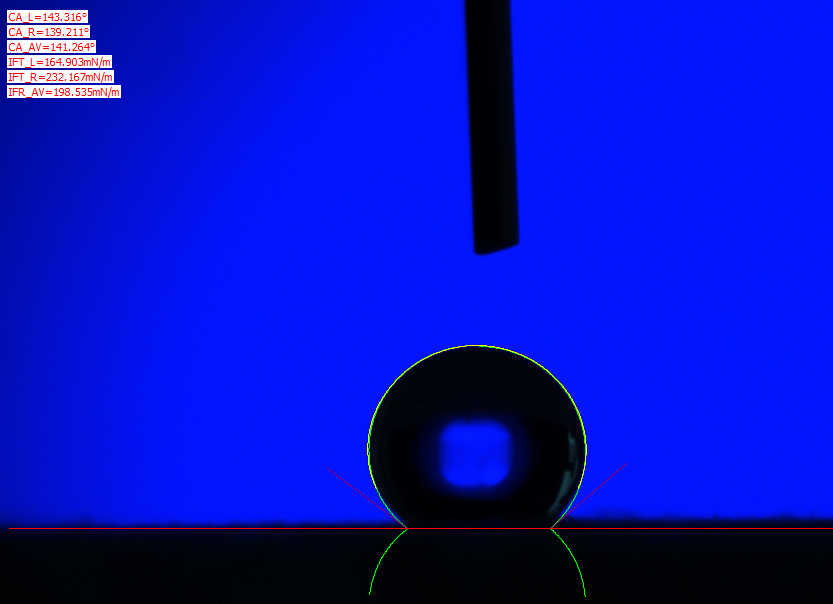
(7) 84 disinfection treatment































